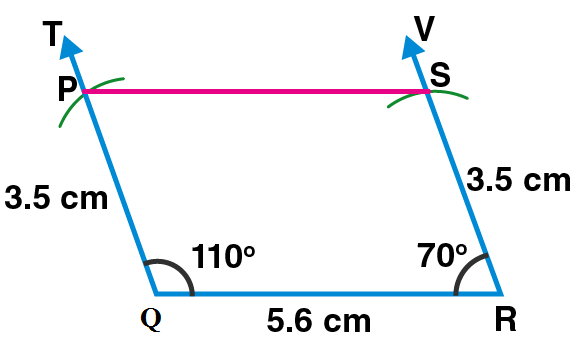Need help? We're here to assist you!
Thank You for Enquiry, we will contact you soon!
Close
The Class 8 is an important year in a student’s life and Maharashtra State Board Maths is one of the subjects that require dedication, hard work, and practice. It’s a subject where you can score well if you are well-versed with the concepts, remember the important formulas and solving methods, and have done an ample amount of practice. Worry not! Home Revise is here to make your Class 8 journey even easier. It’s essential for students to have the right study material and notes to prepare for their board examinations, and through Home Revise, you can cover all the fundamental topics in the subject and the complete Maharashtra State Board Class 8 Maths Book syllabus.

Practice set 8.1 PAGE NO: 43
1. Construct the following quadrilaterals of given measures.
(1) In  MORE, l(MO) = 5.8 cm, l(OR) = 4.4 cm, m∠M = 58°, m∠O = 105°, m∠R = 90°.
MORE, l(MO) = 5.8 cm, l(OR) = 4.4 cm, m∠M = 58°, m∠O = 105°, m∠R = 90°.
(2) Construct  DEFG such that l(DE) = 4.5 cm, l(EF) = 6.5 cm, l(DG) = 5.5 cm, l(DF) = 7.2 cm, l(EG) = 7.8 cm.
DEFG such that l(DE) = 4.5 cm, l(EF) = 6.5 cm, l(DG) = 5.5 cm, l(DF) = 7.2 cm, l(EG) = 7.8 cm.
(3) In  ABCD, l(AB) = 6.4 cm, l(BC) = 4.8 cm, m∠A = 70°, m∠B = 50°, m∠C = 140°.
ABCD, l(AB) = 6.4 cm, l(BC) = 4.8 cm, m∠A = 70°, m∠B = 50°, m∠C = 140°.
(4) Construct  LMNO such that l(LM) = l(LO) = 6 cm, l(ON) = l(NM) = 4.5 cm, l(OM) = 7.5 cm.
LMNO such that l(LM) = l(LO) = 6 cm, l(ON) = l(NM) = 4.5 cm, l(OM) = 7.5 cm.
Solution:
(1)
In
 MORE, l(MO) = 5.8 cm, l(OR) = 4.4 cm, m∠M = 58°, m∠O = 105°, m∠R = 90°.
MORE, l(MO) = 5.8 cm, l(OR) = 4.4 cm, m∠M = 58°, m∠O = 105°, m∠R = 90°.
Steps to construct a quadrilateral:
Step 1: Draw a line MO = 5.8cm.
Step 2: At point O, construct an angle of 105o . Such that it forms a line OX.
Step 3: At point M, construct an angle of 58o . Such that it forms a line MZ.
Step 4: With O as the centre and of radius 4.4cm, cut an arc on the line OX and mark that point as R.
Step 5: Now, at point R construct an angle of 90o . Such that it forms a line RY and the point E is formed intersecting on the line MZ.
Here, is the required MORE quadrilateral.
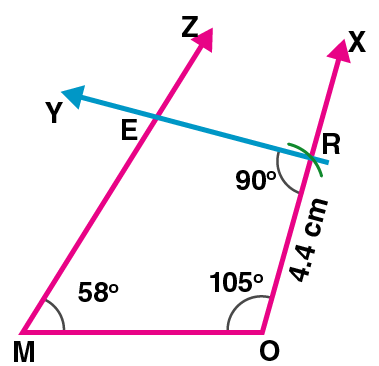
(2)
Construct
 DEFG such that l(DE) = 4.5 cm, l(EF) = 6.5 cm, l(DG) = 5.5 cm, l(DF) = 7.2 cm, l(EG) = 7.8 cm.
DEFG such that l(DE) = 4.5 cm, l(EF) = 6.5 cm, l(DG) = 5.5 cm, l(DF) = 7.2 cm, l(EG) = 7.8 cm.
Steps to construct a quadrilateral:
Step 1: Draw a line DE = 4.5cm.
Step 2: With D as the centre and radius 7.2cm, draw an arc.
Step 3: With E as the centre and radius 6.5cm, draw an arc cutting the previous arc at F.
Step 4: Join EF and DF.
Step 5: With D as the centre and radius 5.5cm, draw an arc.
Step 6: With E as the centre and radius 7.8cm, draw an arc cutting the previous ac at G.
Step 7: Join DG, EG and GF.
Here, is the required DEFG quadrilateral.
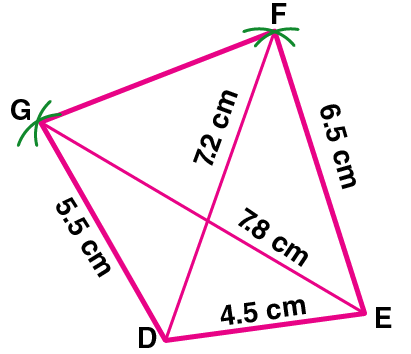
(3)
In
 ABCD, l(AB) = 6.4 cm, l(BC) = 4.8 cm, m∠A = 70°, m∠B = 50°, m∠C = 140°.
ABCD, l(AB) = 6.4 cm, l(BC) = 4.8 cm, m∠A = 70°, m∠B = 50°, m∠C = 140°.
Steps to construct a quadrilateral:
Step 1: Draw a line AB = 6.4cm.
Step 2: construct an angle at point B of 50o
Step 3: With B as the centre and radius of 4.8cm, draw an arc cutting the line BX at point C.
Step 4: construct an angle of 140o at point C and name that line as Y.
Step 5: construct an angle of 70o at point A, such that line AZ and line CY intersect at point D.
Here, is the required ABCD quadrilateral.
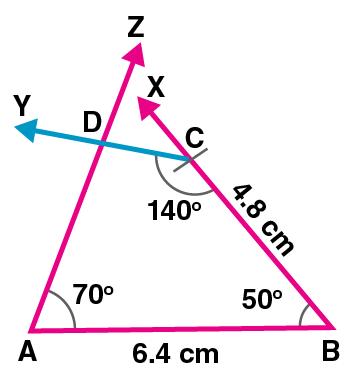
(4)
Construct
 LMNO such that l(LM) = l(LO) = 6 cm, l(ON) = l(NM) = 4.5 cm, l(OM) = 7.5 cm.
LMNO such that l(LM) = l(LO) = 6 cm, l(ON) = l(NM) = 4.5 cm, l(OM) = 7.5 cm.
Steps to construct a quadrilateral:
Step 1: Draw a line LM = 6cm.
Step 2: With L as the centre and radius 6cm, draw an arc.
Step 3: With M as the centre and radius 7.5cm, draw an arc cutting the previous arc at O.
Step 4: Join OL and OL.
Step 5: With O as the centre and radius 4.5cm, draw an arc.
Step 6: With M as the centre and radius 4.5cm, draw an arc cutting the previous ac at N.
Step 7: Join ON, MN and OL.
Here, is the required LMNO quadrilateral.
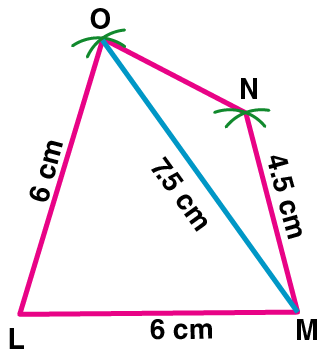
Practice set 8.2 PAGE NO: 46
1. Draw a rectangle ABCD such that l(AB) = 6.0 cm and l(BC) = 4.5 cm.
Solution:
Steps to construct a rectangle:
Step 1: Draw a line AB = 6cm.
Step 2: Construct an angle of 90o at point B.
Step 3: With B as centre and radius 4.5cm, draw an arc cutting the line BX at point C.
Step 4: With C as centre and radius 6cm, draw an arc.
Step 5: With A as the centre and radius 4.5cm, draw an arc cutting the previous arc at point D.
Step 6: Join AD and CD.
Here, is the required ABCD rectangle.

2. Draw a square WXYZ with side 5.2 cm.
Solution:
Steps to construct a square:
Step 1: Draw a line WX = 5.2cm.
Step 2: Construct an angle of 90o at point X.
Step 3: With X as centre and radius 5.2cm, draw an arc cutting the line XP at point Y.
Step 4: With Y as centre and radius 5.2cm, draw an arc.
Step 5: With W as the centre and radius 5.2cm, draw an arc cutting the previous arc at point Z.
Step 6: Join YZ and WZ.
Here, is the required WXYZ square.
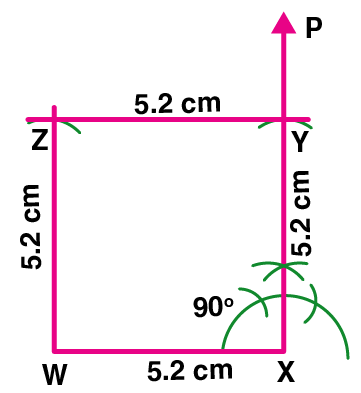
3. Draw a rhombus KLMN such that its side is 4 cm and m∠K = 75°.
Solution:
Steps to construct a rhombus:
Step 1: Draw a line KL = 4cm.
Step 2: Construct an angle of 75o at point K.
Step 3: With K as centre and radius 4cm, draw an arc cutting the line KX at point N.
Step 4: With N as centre and radius 4cm, draw an arc.
Step 5: With L as the centre and radius 4cm, draw an arc cutting the previous arc at point M.
Step 6: Join LM and NM.
Here, is the required KLMN rhombus.
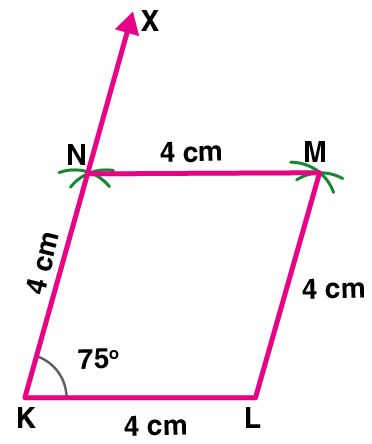
4. If diagonal of a rectangle is 26 cm and one side is 24 cm, find the other side.
Solution:
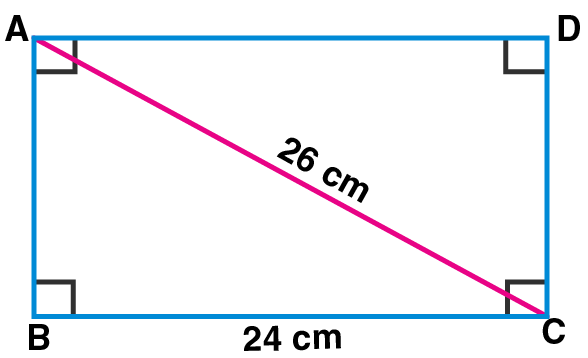
Let ABCD be the rectangle.
l(BC) = 24cm, l(AC) = 26cm
In ∆ABC,
m∠ABC = 90° [Angle of a rectangle]
By using Pythagoras theorem,
[l(AC)]² = [l(AB)]2 + [l(BC)]²(26 )² = [l(AB)]² + (24)²
(26)² – (24)² = [l(AB)]²
(26 + 24) (26 – 24) = [l(AB)]² [Since, a² – b² = (a + b) (a – b)]
50 x 2 = [l(AB)]²
100 = [l(AB)]²
l(AB) = √100
By taking square root of both sides, we get
l(AB) =10 cm
∴The length of the other side is 10 cm.
5. Lengths of diagonals of a rhombus ABCD are 16 cm and 12 cm. Find the side and perimeter of the rhombus.
Solution:
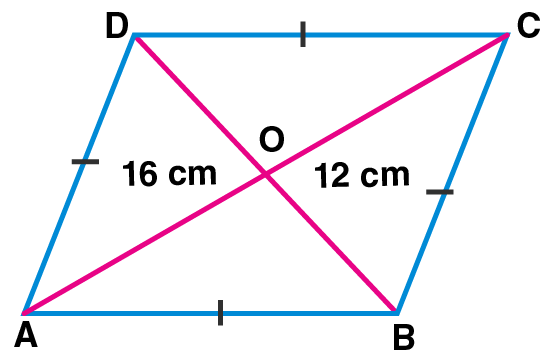
In rhombus ABCD,
It is given that, l(AC) = 16 cm and l(BD) = 12 cm.
Let the diagonals of rhombus ABCD intersect at point O.
l(AO) = 12 l(AC) [Diagonals of a rhombus bisect each other]
l(AO) = 12 × 16
= 8 cm
Also, l(DO) = 12 l(BD) [Diagonals of a rhombus bisect each other]
l(DO) = 12 × 12
l(DO) = 6 cm
In ∆DOA,
m∠DOA = 90° [Diagonals of a rhombus are perpendicular to each other]
By using Pythagoras theorem,
[l(AD)]² = [l(AO)]² + [l(DO)]²= (8)² + (6)²
= 64 + 36
[l(AD)]² = 100l(AD) = √100
By taking square root on both sides, we get
l(AD) = 10 cm
l(AB) = l(BC) = l(CD) = l(AD) = 10 cm [Since, sides of a rhombus are congruent]
Perimeter of rhombus ABCD
= l(AB) + l(BC) + l(CD) + l(AD)
= 10+10+10+10
= 40 cm
∴The side and perimeter of the rhombus are 10 cm and 40 cm respectively.
6. Find the length of diagonal of a square with side 8 cm.
Solution:
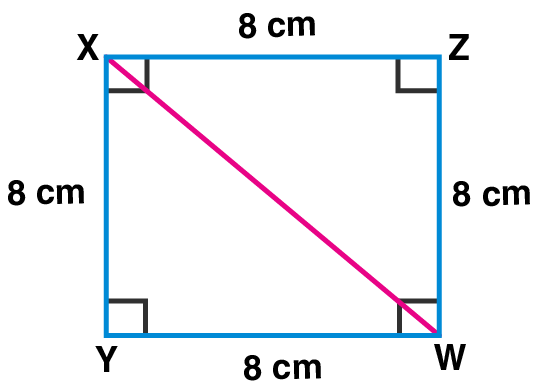
Let XYWZ be the square of side 8cm.
seg XW is a diagonal.
In ∆ XYW,
m∠XYW = 90° [Angle of a square]
By using Pythagoras theorem,
[l(XW)]² = [l(XY)]² + [l(YW)]²= (8)² + (8)²
= 64 + 64
[l(XW)]² = 128By taking square root on both sides, we get
l(XW) = √128
= √64 × 2
= 8 √2 cm
∴ The length of the diagonal of the square is 8 √2 cm.
7. Measure of one angle of a rhombus is 50°, find the measures of remaining three angles.
Solution:
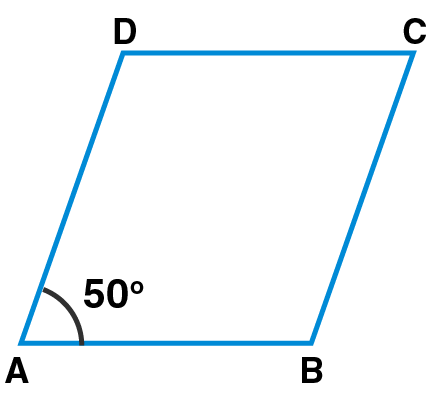
Let ABCD be the rhombus.
m∠A = 50°
m∠C = m∠A [Since, opposite angles of a rhombus are congruent]
∴ m∠C = 50°
Also, m∠D = m∠B …(i) [Opposite angles of a rhombus are congruent]
In rhombus ABCD, we know that sum of the measures of the angles of a quadrilateral is 360°.
m∠A + m∠B + m∠C + m∠D = 360°
50° + m∠B + 50° + m∠D = 360°
m∠B + m∠D + 100° = 360°
m∠B + m∠D = 360° – 100°
m∠B + m∠B = 260° [From (i)]
2m∠B = 260°
m∠B = 260/2
m∠B = 130°
m∠D = m∠B = 130° [From (i)]
∴ The measures of the remaining angles of the rhombus are 130°, 50° and 130°.
Practice set 8.3 PAGE NO: 49
1. Measures of opposite angles of a parallelogram are (3x – 2)° and (50 – x)°. Find the measure of its each angle.
Solution:
Let PQRS be the parallelogram.
m∠Q = (3x – 2)° and m∠S = (50 – x)°
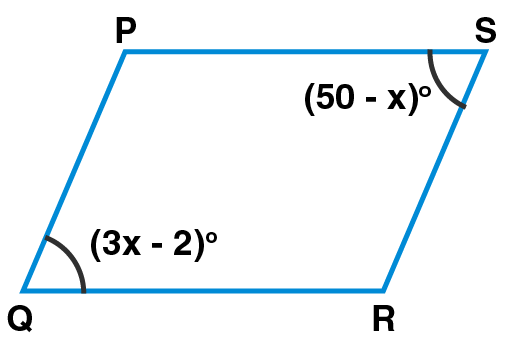
m∠Q = m∠S …..(i) [Since, opposite angles of a parallelogram are congruent]
3x – 2 = 50 – x
3x + x = 50 + 2
4x = 52
x = 52/4
x = 13
Now, m∠Q = (3x – 2)°
(3 × 13 – 2)° = (39 – 2)° = 37°
m∠S = m∠Q = 37° [From(i)]
m∠P + m∠Q = 180° [Since, adjacent angles of a parallelogram are supplementary]
m∠P + 37° = 180°
m∠P = 180° – 37° = 143°
m∠R = m∠P = 143° [Since, opposite angles of a parallelogram are congruent]
∴ The measures of the angles of the parallelogram are 37°, 143°, 37° and 143°.
2. Referring the given figure of a parallelogram, write the answers of questions given below.
(1) If l(WZ) = 4.5 cm, then l(XY) = ?
(2) If l(YZ) = 8.2 cm, then l(XW) = ?
(3) If l(OX) = 2.5 cm, then l(OZ) = ?
(4) If l(WO) = 3.3 cm, then l(WY) = ?
(5) If m∠WZY = 120°, then m∠WXY = ? and m∠XWZ = ?

Solution:
(1) It is given that, l(WZ) = 4.5 cm
l(X Y) = l(WZ) [Since, opposite sides of a parallelogram are congruent ]
∴ l(X Y) = 4.5cm
(2) It is given that, l(YZ) = 8.2 cm
l(XW) = l(YZ) [Since, opposite sides of a parallelogram are congruent]
∴ l(XW) = 8.2cm
(3) It is given that, l(OX) = 2.5 cm
l(OZ) = l(OX) [Since, diagonals of a parallelogram bisect each other]
∴ l(OZ) = 2.5cm
(4) It is given that, l(WO) = 3.3 cm
l(WO) = 1/2 l(WY) [Since, diagonals of a parallelogram bisect each other]
3.3 = 1/2 l(WY)
3.3 × 2 = l(WY)
∴ l(WY) = 6.6cm
(5) It is given that, m∠WZY =120°
m∠WXY = m∠WZY [Since, opposite angles of a parallelogram are congruent]
So, m∠WXY = 120o
Now,
m∠XWZ + m∠WXY = 180° [Since, adjacent angles of a parallelogram are supplementary]
m∠XWZ + 120° = 180°
m∠XWZ = 180°- 120°
∴ m∠XWZ = 60°
3. Construct a parallelogram ABCD such that l(BC) = 7 cm, m∠ABC = 40°, l(AB) = 3 cm.
Solution:
Steps to construct:
Step 1: Draw a line AB = 3cm.
Step 2: Construct an angle of 40o at point B.
Step 3: With B as centre and radius 7cm, draw an arc cutting the line BX at point C.
Step 4: With C as centre and radius 3cm, draw an arc.
Step 5: With A as the centre and radius 7cm, draw an arc cutting the previous arc at point D.
Step 6: Join AD and CD.
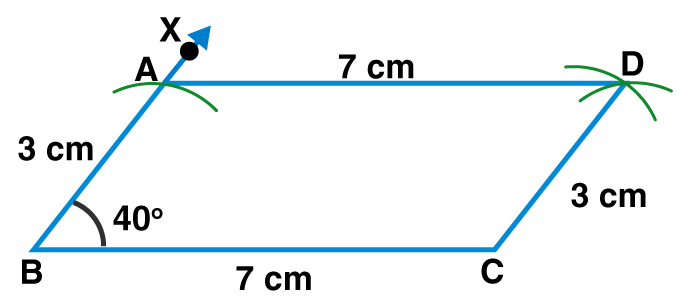
Opposite sides of a parallelogram are congruent.
∴ l(AB) = l(CD) = 3cm
l(BC) = l(AD) = 7 cm
4. Ratio of consecutive angles of a quadrilateral is 1: 2: 3: 4. Find the measure of its each angle. Write with reason, what type of a quadrilateral it is.
Solution:
Let PQRS be the quadrilateral.
Ratio of consecutive angles of a quadrilateral is 1: 2: 3: 4.
Let us consider ‘x’ be the common multiple.
∴m∠P = x°, m∠Q = 2x°, m∠R = 3x° and m∠S = 4x°
In quadrilateral PQRS,
m∠P + m∠Q + m∠R + m∠S = 360° [Sum of the measures of the angles of a quadrilateral is 360°]
x° + 2x° + 3x° + 4x° = 360°
10 x° = 360°
x° = 360/10
x° = 36°
∴m∠P = x° = 36°
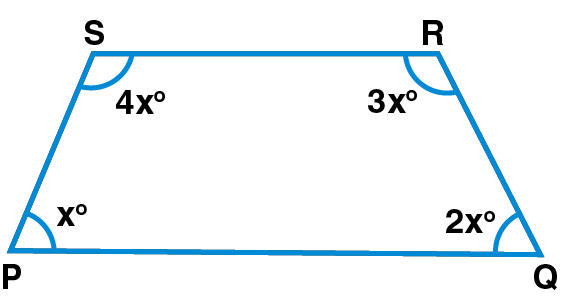
m∠Q = 2x° = 2 × 36° = 72°
m∠R = 3x° = 3 × 36° = 108° and
m∠S = 4x° = 4 × 36° = 144°
∴The measures of the angles of the quadrilateral are 36°, 72°, 108°, 144°.
Here, m∠P + m∠S = 36° + 144° = 180°
side PQ || side SR [Since, interior angles are supplementary]
m∠P + m∠Q = 36° + 72°
= 108°
≠ 180°
So, side PS is not parallel to side QR.
Since, one pair of opposite sides of the given quadrilateral is parallel.
∴The given quadrilateral is a trapezium.
5. Construct  BARC such that l(BA) = l(BC) = 4.2 cm, l(AC) = 6.0 cm, l(AR) = l(CR) = 5.6 cm.
BARC such that l(BA) = l(BC) = 4.2 cm, l(AC) = 6.0 cm, l(AR) = l(CR) = 5.6 cm.
Solution:
Steps to construct:
Step 1: Draw a line BA = 4.2cm.
Step 2: With B as the centre and radius 4.2cm, draw an arc.
Step 3: With A as the centre and radius 6cm, draw an arc cutting the previous arc at C.
Step 4: Join BC and AC.
Step 5: With A as the centre and radius 5.6cm, draw an arc.
Step 6: With C as the centre and radius 5.6cm, draw an arc cutting the previous ac at D.
Step 7: Join AD, CD and BC.
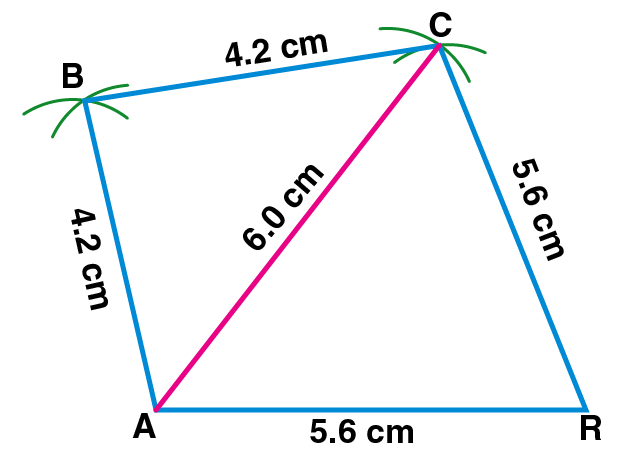
6. Construct  PQRS, such that l(PQ) = 3.5 cm, l(QR) = 5.6 cm, l(RS) = 3.5 cm, m∠Q = 110°, m∠R = 70°.
PQRS, such that l(PQ) = 3.5 cm, l(QR) = 5.6 cm, l(RS) = 3.5 cm, m∠Q = 110°, m∠R = 70°.
If it is given that  PQRS is a parallelogram, which of the given information is unnecessary?
PQRS is a parallelogram, which of the given information is unnecessary?
Solution:
Steps to construct:
Step 1: Draw a line PQ = 3.5cm.
Step 2: Construct an angle of 110o at point Q.
Step 3: With Q as centre and radius 5.6cm, draw an arc cutting the line QX at point R.
Step 4: Construct an angle of 70o at point R.
Step 5: With R as the centre and radius 3.5cm, draw an arc cutting the Line RY at point S.
Step 6: Join RS and PS.
